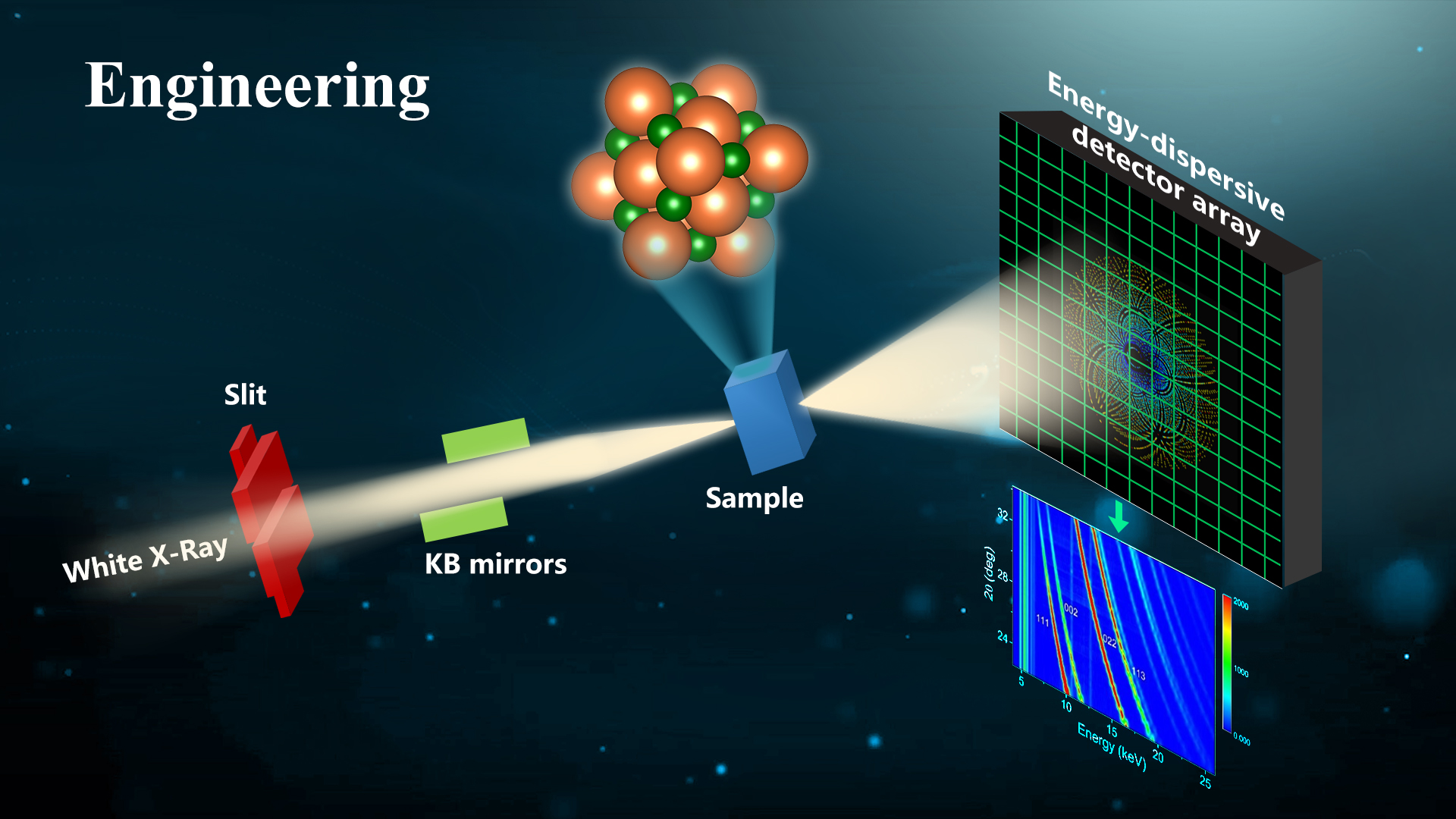Rapid acquisition of fundamental data on the structure and composition in material genomic mapping has always been the bottleneck of high-throughput characterization techniques. To address this challenge, the characterization efficiency of existing X-ray diffraction (XRD) and fluorescence (XRF) experiments has to be greatly improved.
At present, the traditional ways to improve the characterization efficiency include: 1) using synchrotron undulator source to increase the X-Ray flux at the sample; 2) using a single wavelength incident beam with a two-dimensional detector array, or continuous wavelength X-ray source with a single-point energy-dispersive detector to avoid angular scanning; 3) combining diffraction and fluorescence techniques to measure the structure and composition of materials simultaneously. So far, angle-resolved XRD (ARXRD) and energy-dispersive XRD (EDXRD) are the two main separate approaches to improving XRD efficiency. The former takes advantage of the wide range of diffraction angles, and the other takes advantage of the polychromatic X-ray; neither can maximize the utilization of photon flux and detector coverage.

Chair Professor X.-D. Xiang’s research team from the Department of MSE and Physics at the Southern University of Science and Technology (SUSTech), in collaboration with Shanghai Jiao Tong University (SJTU) and the Institute of High Energy Physics of the Chinese Academy of Sciences (IHEP, CAS), recently published important achievements in the research of high-throughput characterization of material structure and composition.
Their research, entitled “High-Throughput Powder Diffraction Using White X-Ray Beam and a Simulated Energy-Dispersive Array Detector,” was published in the top journal Engineering.
For ARXRD, the synchrotron X-ray flux loses four orders of magnitude during the monochromatic process. For EDXRD, the effective diffraction signals are received by a single energy-dispersive detector, which can only cover an extremely small space, resulting in signal loss of several orders of magnitude. In order to maximize the use of white X-Ray flux and diffraction signal, Prof. Xiang’s team innovatively proposed the characterization technique of polychromatic X-ray combined with energy dispersive detector array (2D-EDXRD) in 2015, which is expected to realize high-throughput characterization of microstructure and composition of samples (X.-D. Xiang, Gang Wang, Xiaokun Zhang, Yong Xiang, Hong Wang, Engineering 2015, 1:2).
The diffraction efficiency of 2D-EDXRD is expected to increase by four orders of magnitude compared with ARXRD and EDXRD. To solve the technical problem of the lack of an energy-dispersive detector array, they simulated an 88-pixel 2D detector array by moving a single-point silicon-drift detector (SDD) in an (11 × 8)-point grid in space and simultaneously collected diffraction and fluorescence signals. The fluorescence peaks are solely dependent on the elements present in the sample and do not change with pixel position. As a result, the fluorescence and diffraction can be easily distinguished by comparing the spectra measured at multiple diffraction angles.
The diffraction signal is then converted to q-space (1/d) and corrected carefully for hardware-related factors and diffraction angle dependency, resulting in relative peak heights that were well consistent with ARXRD. The 2D detector array not only proportionally increased the signal counts but also improved the S/N ratio. The diffraction signal enhancement by 2D-EDXRD over 2D-ARXRD under the experimental conditions was about 104-fold, verifying the early idea. The full width at half maximum (FWHM) of the peaks in q-space is found to be dependent on the energy resolution of the detector, the angle span of the detector, and the diffraction angle.
It is possible for EDXRD to achieve the same or even smaller FWHM as ARXRD under the energy resolution of the current detector if the experimental parameters are appropriately chosen, which is of great significance for the characterization of nanocrystalline, amorphous, and other materials.

Figure 1. Spectra separated from the data collected by the simulated 88-pixel energy-dispersive detector array: (a) pure fluorescence spectra; (b) pure diffraction spectra converted to a function of 1/d; (c) data of (b) corrected by Ihardware and A(E); and (d) data of (c) corrected with λ and ϕ(θ).
The pioneering work of combinatorial materials chip (X.-D. Xiang et al., Science, 268, 1738:1995) invented by Prof. Xiang in the 1990s on high-throughput preparation and characterization lays the foundation for the Materials Genome Project. Although the high-throughput preparation technique has gained a great advantage, the lack of non-destructive, in-situ, micro high-throughput structure and composition characterization techniques have been the main bottleneck of the material data shortage so far.
This research not only verifies the feasibility of the high-throughput powder diffraction using white x-ray beam and energy-dispersive array detector array, but also realizes the simultaneous characterization of structure and composition. In addition, this technique is also a huge breakthrough in the existing ARXRD and EDXRD by expanding the energy and space dimensions, laying a solid foundation for ultrafast high-resolution XRD technique. It will elevate materials science into a new age of AI-based “Fourth Paradigm”.
Dr. Wang Xiaoping, a visiting scholar at SUSTech and Research Assistant at SJTU, is the first author of this paper. Prof. X.-D. Xiang from SUSTech, Prof. Hong Wang from SJTU, and Prof. Peng Liu from IHEP, CAS are the co-corresponding authors. Other authors include Dr. Weiwei Dong from IHEP, CAS, Research Assistant Prof. Peng Zhang and Haoqi Tang from the Academy for Advanced Interdisciplinary Studies at SUSTech, Prof. Lanting Zhang from SJTU, and Associate Prof. Tieying Yang from the Shanghai Advanced Research Institute of the Chinese Academy of Sciences.
This research work has been supported by the National Key Project of Research and Development Plan and High-level Special Funds.
Paper link: https://doi.org/10.1016/j.eng.2021.05.023
To read all stories about SUSTech science, subscribe to the monthly SUSTech Newsletter.
Proofread ByAdrian Cremin, Yingying XIA
Photo By